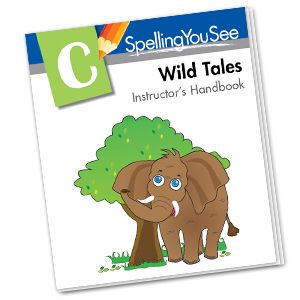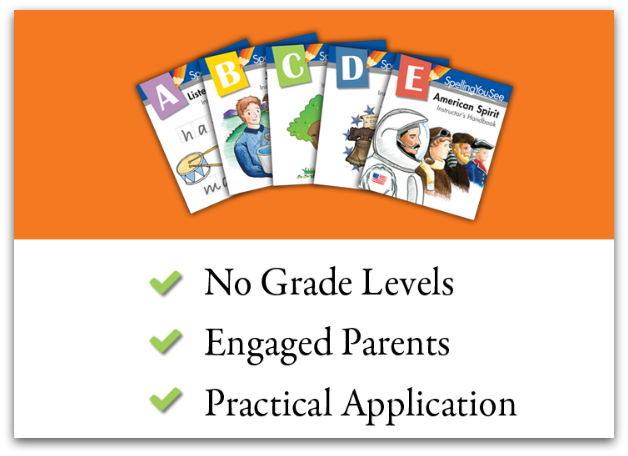Should we do formal spelling? Maybe we don't need formal spelling. Yes, we need to do formal spelling lessons. We are going to take a pre-test on Mondays, worksheets all week, and then a final test on Fridays. No, we are just going to read a lot and learn spelling that way.
Yes, this is the conversation I have with myself almost daily when it comes to formal spelling lessons. Spelling You See, created by the wildly popular Demme Learning group who also provides Math-U-See, follows the philosophy that there are five developmental stages of spelling: preliterate, phonetic, skill development, word extension, and derivational constancy. They believe you must complete one stage before moving onto the next, and that it is not effective to follow the pre-test/worksheets/final test philosophy. They also believe in short lessons with lots of copy work and dictation. I was very attracted to this approach to spelling lessons and was happy to review the product.

We received a pdf version of Wild Tales (Level C) for the purpose of this review. (Note: Spelling You See does not offer electronic download versions of their products. All of their products are in physical, paperback book format.)

The first step in using Spelling You See is to determine what level you need for your student. Although the products are designed for all elementary students, or as remedial work for older students, Spelling You See is not set up by grade level and levels are not designed for particular ages.

There are five levels available:
- Listen and Write (Level A)
- preliterate and phonetic stage
- learn correct pencil grip, correct letter formation, consonants, and short vowels
- View Level A sample lesson
- Jack and Jill (Level B)
- phonetic stage to skill development stage
- nursery rhymes help students develop an understanding of simple narrative sequences and provide expanded opportunities for vocabulary development
- View Level B sample lesson
- Wild Tales (Level C)
- skill development stage
- students will participate in guided writing and "chunking" letter patterns with opportunities for copy work, free writing, and writing from dictation
- View Level C sample lesson
- Americana (Level D)
- skill development stage
- utilizes the three core activities of Spelling You See: chunking letter patterns, copy work, and dictation
- View Level D sample lesson
- American Spirit (Level E)
- skill development stage
- continuing with the three core activities, students will read about people and events from American History
- View Level E sample lesson
How We Used the Product
During the review period we were able to complete seven full lessons. Lessons 1-7 continue the nursery rhyme theme from Jack and Jill (Level B). (Starting with Lesson 8, the passages change to non-fiction facts about animals.) Each day during spelling time I gave the kids one worksheet from our current level. There are five worksheets for each lesson, and we completed them as follows:
- Day 1 - read the nursery rhyme out loud together, use a crayon to "chunk" the assigned letter patterns, turn the page over and copy part of the nursery rhyme, then go through the copied text and circle the letter chunks.
- Day 2 - read the nursery rhyme out loud together, use a crayon to "chunk" the assigned letter patterns, turn the page over and copy another part of the nursery rhyme, then go through the copied text and circle the letter chunks.
- Day 3 - read the nursery rhyme out loud together, use a crayon to "chunk" the assigned letter patterns, turn the page over and copy the assigned part of the nursery rhyme, then go through the copied text and circle the letter chunks.
- Day 4 - read the nursery rhyme out loud together, use a crayon to "chunk" the assigned letter patterns, turn the page over and have either free writing or drawing time! This was a change from the norm. It gave the kids an opportunity expand on the nursery rhyme or just draw or write something of their choice. Most times the kids illustrated the nursery rhyme.
- Day 5 - read the nursery rhyme out loud together, use a crayon to "chunk" the assigned letter patterns, turn the page over and try to write the nursery rhyme from dictation.
More about Chunking
Chunking is really just identifying regular letter patterns. In the first seven lessons, the letter patterns identified were vowel chunks (i.e. aa, ie, ew, ou), consonant chunks (i.e. ch, kn, dg, ww), the bossy r, the tricky y guy, and the silent e. These are regular letter patterns that the students will encounter over and over again. Learning to spell isn't as much about phonics rules as it is about letter patterns.
More on Day 5
The idea is for the kids to have recited, copied, and worked with the letter patterns so much during the week that on Day 5 they can write and spell the nursery rhyme with dictation. The instructions make it clear to only have your students write what they can in 10 minutes of dictation. If you don't get done in 10 minutes then just stop where you are. Once they are done, go through the written text of your child and circle each word spelled and written correctly. At the bottom of the page write the number of correctly spelled words. This gives your child a sense of accomplishment instead of having missed words be the focus.
My Opinion
I feel like we were just starting to get our feet wet with Spelling You See. I appreciate that each lesson only takes 5 to 10 minutes to complete. And, believe me, my kids appreciate it, too! They do not feel that they are doing spelling work. It feels more like handwriting practice to them.
Although we had a previous spelling curriculum that we really liked, with worksheets the kids truly enjoyed, we had to ditch it because Eli would get so stressed about getting all of his spelling words correct on both the pre-test and final test that he couldn't hardly even write the words. His sister being a naturally good speller did not help matters at all as she was sitting next to him saying, "yes!" every time she got a word right. Spelling You See is exactly what I was looking for … a solid spelling program that teaches spelling alongside a child's natural level of development, without the stress of tests. No more feeling like both kids should know "these" words because they are in the 3rd or 4th grade or whatever. No more spelling lists to memorize and regurgitate.
I do not feel as though we have used the program long enough to make a final determination as to whether this method of spelling will be effective for both of my children. But, I like what I see so far and we will continue to use it. Math-U-See has been a winner for us in math and I believe Spelling You See will be, as well.
Although the nursery rhymes seemed a little "babyish" to my 10 year old boy, I absolutely loved that at the end of the first 7 weeks my kids and I could chant some favorite nursery rhymes together. Some of the rhymes they have never heard before, so it was fun to share something classic from my childhood. I believe they will be ready to move onto the nonfiction passages about animals with Lesson 8 that we will start this week.
Product Details
All five levels can be purchased at the Spelling You See website. The instructor's handbooks are $14 each (except for Jack and Jill - Level B which is $16) and the student packs are $30 each (except for Listen and Write - Level A which is $20). The total price of both items for Wild Tales - Level C is $44 for one student. The student pack for Wild Tales - Level C includes two student workbooks (half of the lessons in one book and half in the other book and a pack of erasable colored pencils for "chunking". There are a total of 36 lessons.
To read more reviews about Wild Tales (Level C) or any of the other levels of Spelling You See, hop over to the Schoolhouse Review Crew blog.
To read more reviews about Wild Tales (Level C) or any of the other levels of Spelling You See, hop over to the Schoolhouse Review Crew blog.



Thanks for the review, was very helpful. I loved taking a look and reading through the rest of your blog as well. I was quite surprised to see that I know your family! :) --Amber Cox
ReplyDeleteHi Amber!! How funny that you found us this way! Let me know if you have any questions about this or any other homeschooling issues. I am a homeschooling nerd, sorry to say. Get in touch with Kyndal and we can connect!!
Delete